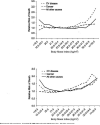The medical risks of obesity
- PMID: 19940414
- PMCID: PMC2879283
- DOI: 10.3810/pgm.2009.11.2074
The medical risks of obesity
Abstract
Obesity is at epidemic proportions in the United States and in other developed and developing countries. The prevalence of obesity is increasing not only in adults, but especially among children and adolescents. In the United States in 2003 to 2004, 17.1% of children and adolescents were overweight, and 32.2% of adults were obese. Obesity is a significant risk factor for and contributor to increased morbidity and mortality, most importantly from cardiovascular disease (CVD) and diabetes, but also from cancer and chronic diseases, including osteoarthritis, liver and kidney disease, sleep apnea, and depression. The prevalence of obesity has increased steadily over the past 5 decades, and obesity may have a significant impact on quality-adjusted life years. Obesity is also strongly associated with an increased risk of all-cause mortality as well as cardiovascular and cancer mortality. Despite the substantial effects of obesity, weight loss can result in a significant reduction in risk for the majority of these comorbid conditions. Those comorbidities most closely linked to obesity must be identified to increase awareness of potential adverse outcomes. This will allow health care professionals to identify and implement appropriate interventions to reduce patient risk and mortality. A systematic search strategy was used to identify published literature between 1995 and 2008 that reported data from prospective longitudinal studies of obesity and comorbid medical conditions. This article will review evidence for significant associations of obesity with comorbidities to provide information useful for optimal patient management.
Figures




References
-
- National Heart, Lung, and Blood Institute Clinical guidelines on the identification, evaluation, and treatment of overweight and obesity in adults. [October 10, 2008]; http://www.nhlbi.nih.gov/guidelines/obesity/ob_home.htm. - PubMed
-
- World Health Organization Physical status: the use and interpretation of anthropometry. Report of a WHO Expert Committee. World Health Organ Tech Rep Ser. 1995;854:1–452. - PubMed
-
- Centers for Disease Control (CDC) BRFSS, Behavioral Risk Factor Surveillance System Survey Data, Atlanta, Georgia: US Department of Health and Human Services. [October 10, 2008]; http://www.cdc.gov/brfss.
-
- Ogden CL, Carroll MD, Flegal KM. High body mass index for age among US children and adolescents, 2003-2006. JAMA. 2008;299(20):2401–2405. - PubMed
-
- Ogden CL, Carroll MD, Curtin LR, McDowell MA, Tabak CJ, Flegal KM. Prevalence of overweight and obesity in the United States, 1999-2004. JAMA. 2006;295(13):1549–1555. - PubMed
Publication types
MeSH terms
Grants and funding
LinkOut - more resources
Full Text Sources
Other Literature Sources
Medical
Miscellaneous
